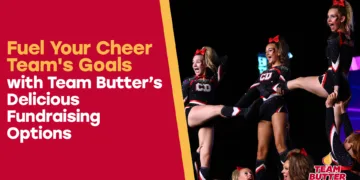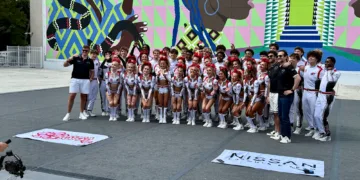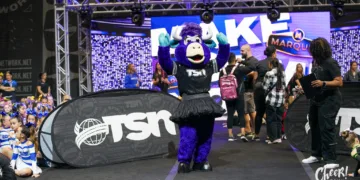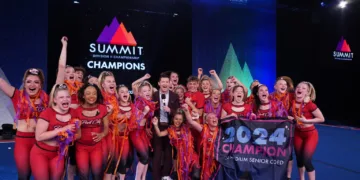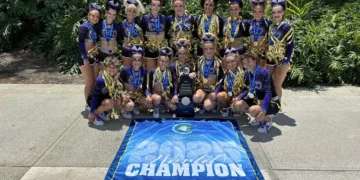Welcome to the Ultimate Cheerleading Glossary covering 137 cheerleading terms, brought to you by Cheer Daily! Whether you’re a seasoned cheerleader or new to the sport, understanding the terminology is crucial to mastering the skills and stunts. This comprehensive glossary covers everything from basic moves to advanced stunts, ensuring you’re well-prepared for any cheerleading challenge. Dive in and get to know the language of cheerleading!
Aerial
Tumbling skill performed without hands; often a side aerial (no-handed cartwheel).
Arabesque
Body position for stunting where the flyer stands on one leg with the other leg extended straight behind, arms in a T; the entire stunt group should face the side.
Arabian
A flip that takes off backwards, does a half turn, and lands facing the front.
Around the World
Advanced cheerleading jump in which the legs come up in a pike, then open to a toe touch before landing.
Awesome
Extension with the flyer’s feet close together, also known as a Cupie.
Backbend
Position in which the feet and hands maintain contact with the floor while the back arches and stomach pushes up toward the ceiling (see also: bridge).
Back Handspring
Tumbling skill that involves jumping backwards and passing through a handstand position before landing back on the feet.
Back Tuck
Back flip with legs in a tucked position.
Backspot/Back Base
Stunt position in the back of the stunt group responsible for maintaining contact with the flyer’s ankles and calling the counts for the stunt.
Baja
Stunt in which the flyer does a front flip while maintaining contact with a brace on the floor. Technical name is a suspended roll.
Barrel Roll
A flyer is tossed from a cradle position, executes a full twist parallel to the ground before being caught in the cradle position again. Also called a “log roll”.
Base
Stunt position that does the lifting.
Basket Toss
Stunt where bases throw the flyer in the air and the flyer performs a skill before being caught. The bases’ hands interlock like a woven basket.
Blades
Hand position with hands flat and fingers together.
Block
The bounce or pop action in the shoulders needed for tumbling skills such as a back handspring.
Body Position
The skill performed by a flyer in a single-legged stunt.
Bow and Arrow
Single-leg body position where the flyer extends one leg straight up, grabbing with the opposite arm. The other arm is extended in a T in front of the leg, creating a shape that resembles a bow and arrow.
Brace
A prep-level stunt group whose flyer maintains contact with another group’s flyer as they perform a skill.
Breakaway/Breakthrough Banner
A large banner that the team runs through as they enter the field or court before a game. Some teams make a new paper banner for each game, others invest in a fabric or vinyl banner for multiple uses.
Bridge
A foundational tumbling skill where the hands and feet maintain contact with the ground while the belly button extends toward the ceiling.
Broken T
A motion with both arms bent parallel to the ground with fists in front of shoulders.
Buckets
Motion with both arms extended directly in front of the body, parallel to each other and the ground; fists face toward the ground as if holding two buckets of water.
Bump Down
Stunt dismount that essentially performs the stunt in reverse to end in the beginning load position.
Camp
An intensive practice where cheerleaders are taught a range of skills and materials, often by an outside instructor. These can be single-day or multi-day events involving travel.
Candlesticks
Motion with both arms extended directly in front of the body, parallel to each other and the ground; fists face inward as if holding two candles straight up.
Captain
A member of the team chosen by the coach or their teammates to serve as a leader. Captain responsibilities vary from team to team.
Cartwheel
Foundational tumbling skill that takes off from the tumbler’s dominant leg, passes sideways through a handstand position with the legs apart, ending on the opposite leg. It resembles the spokes of a wagon or cart wheel as it turns.
Chair Sit
Partner stunt where the flyer is in a liberty-style position while the base has one hand under her seat and the other hand supporting her lower ankle.
Chant
A short phrase or series of words and letters that is yelled with motions and repeated multiple times to encourage the crowd to yell along. These are performed throughout a game and make up a majority of sideline “cheering”.
Cheer
A longer string of phrases that is yelled and incorporates motions, jumps, stunts, tumbling, and often spirit props. These are generally performed between quarters, during halftime or timeouts, or as a standalone routine for a competition.
Chin-Chin
Stunting body position in which the flyer brings one leg up and hooks her foot under her chin.
Clap
Bringing the hands together in the blade position in front of the chest; a clap is not very loud and is primarily used for appearance.
Clasp
Bringing the hands together in a cupped position in front of the chest; a clasp is used most often in cheerleading as it creates a louder sound than a clap.
Clean
Standing with feet together and arms pressed tightly to the sides.
Clinic
A shorter version of camp, usually lasting a few hours; can cover several areas or focus on one specific area (a stunt clinic, for example).
Competition
Event where multiple cheerleading teams perform a routine and are evaluated by a panel of judges to receive the highest score.
Cradle
Stunt dismount where the bases release the flyer’s feet and catch her in a reclined position, bases should have one arm under the flyer’s legs and the other behind her/his back.
Crop
Long sleeve garment worn underneath a uniform shell and ending underneath the bust. Should be form-fitted.
Cupie
Partner stunt where a singular base is holding both of the flyer’s feet in one hand in an extended position. (This term is sometimes used interchangeably with “awesome” when referring to group stunts).
Daggers
Motion with both arms bent in front of the chest, elbows pointing down, and fists facing each other.
Dead Mat
A foam mat without springs underneath used by school teams for practice and competition.
Double
Short for “double full”; a variety of skills that incorporate two full twists such as a cradle or layout.
Dismount
The method used to get out of a stunt.
Double Nine
Jump where one leg extends straight in front and the other bends so that the foot is touching the knee to create a “9” shape, with arms mimicking that motion.
Drill
An exercise or part of a skill that is performed repetitively to increase understanding and muscle memory for that specific part of the skill.
Elevator
Also known as a prep, this is a foundational stunt. Two bases and a backspot hold the flyer at shoulder-level on both feet.
Extension
Stunt where the flyer stands on both feet, with the bases’ arms fully extended overhead.
Flyer
The cheerleader that is lifted in the air during stunts.
Formation
The placement of cheerleaders on the floor or sideline during a routine. Common formations are windows or a V.
Free Stretch
Very similar to a heel stretch, but the flyer lets go of the foot and extends both arms to the side, using her strength to keep the leg in the air.
Front Handspring
Tumbling skill that takes off forward and passes through the handstand position (legs together) before landing on the feet.
Front Hurdler
Jump where one leg extends straight in the front and the other bends in the back, arms are most often in a touchdown motion, but can also be in a high V. The leg in front determines whether it is a “right” or “left” jump.
Front Spot
Stunt position that provides additional support in the front of the stunt by grabbing the flyer’s shins or the bases’ wrists. A front spot is generally used when first learning a stunt, though they are frequently used in basket tosses for added height.
Front Tuck/Punch Front
Front flip without hands. In cheerleading, a punch front with a step out is often used at the beginning of a tumbling pass before a round-off to add difficulty.
Full
Any skill with a 360-degree rotation. Often used to refer to a full-twisting layout.
Full Down
A cradle with a full twist before the catch.
Full Up
When the flyer does a full spin at the beginning of the stunt in transition from the load-in before hitting the final position.
Full-Out
When a team performs all aspects of a routine during practice, including stunts, jumps, and tumbling. (During practice, a team may “mark” parts of a routine to save energy).
Gameday Competition
A relatively recent addition to cheerleading competition, the gameday division evaluates school teams on a band dance, a crowd involvement cheer, an offense or defense chant, and the team’s fight song dance.
Grip
How the bases hold the flyer’s foot for a stunt.
Heel Stretch
Stunting body position where the flyer pulls one leg up diagonally in front of the body, the other arm does a high V.
Helicopter
Flyer is tossed in a prone position and rotates on the horizontal axis before being caught again, resembling the blades of a helicopter. Can also be performed with multiple groups who all toss their flyer to the group next to them as the flyers hold hands.
Herkie
Jump where one leg extends to the side as in a toe touch and the other is bent with the knee pointing down. Traditionally performed with the arms in a punch motion. Named after Lawrence Herkimer.
High V
Motion with both arms at about a 45-degree angle overhead, fists should be facing out.
Hitch
Body position in stunting where a flyer stands on one leg while the other leg is bent and connects to another stunt group.
Hurdle
Running tumbling element used by an athlete to gain power and momentum before the round-off.
Inversion
Any stunt where the flyer’s feet are higher than her head.
Jump
In cheerleading, a jump specifically refers to when a cheerleader’s feet leave the ground and he/she executes one of the recognized jump positions before landing.
Layout
A flip where the tumbler’s body stays completely straight for the duration of the skill; can be performed front or back, but is most often performed backwards in cheerleading.
Liberty
The easiest single-leg body position, involves placing the toe of the non-standing leg to the standing knee, with both knees facing forward.
Load
The beginning of the stunt when the bases first grab the flyer’s feet/foot. The flyer should support her own weight in the bases’ shoulders.
Low V
Motion with both arms extended about 45 degrees below chest level.
Main Base
This is generally the base on the flyer’s right side (or the base on the left if you are looking at the group from the front). There is little difference in bases during most two-legged stunts; however, the main base is the one who keeps the heel-toe grip during a single leg stunt.
Megaphone
Spirit prop that is used to help project a cheerleader’s voice further.
Motion
The arm and leg positions that correspond to words or counts during cheers, chants, and routines.
Needle
Used to describe a straight-leg scorpion body position.
Non-Building
A team that does not stunt; some competitions have divisions specifically for non-building teams.
Non-Tumbling
A team that does not tumble; some competitions have divisions specifically for non-tumbling teams.
Paper Doll
A pyramid where multiple flyers connect arms while doing the same body position (generally a liberty or heel stretch). The resulting visual is reminiscent of an unfolded paper doll chain.
Partner Stunt
A stunt where a single base lifts a flyer; generally, this is coed, but there has been an increase in all-girl partner stunts.
Pike
Jump position where both legs extend straight in front together, like one is folding in half. A pike position can also be used in tumbling.
Pivot
A turning motion where one foot stays planted.
Pom Pom
Spirit prop made of shreds of colored plastic or vinyl that is used to accentuate motions and grab attention.
Pop Off
A stunting dismount where the flyer is released with a slight toss and lands on the ground with her feet together. Bases should reach for the flyer as she comes down and slow her down significantly before she reaches the ground.
Post
Single-leg stunt position where the non-standing leg is pressed close against the standing leg as if in a clean. This is used after extending into the single leg stunt before pulling the body position, though is not a requirement.
Post Up
Way to get into a stunt where the flyer holds the hands or shoulders of someone on the floor in front of the stunt. This person is used as a lever that the flyer can lean on as the base(s) lift(s) the flyer.
Prep
Used interchangeably with “elevator”; two bases and a backspot hold the flyer at shoulder-level on both feet.
Prone
Position where the flyer is held laying face down.
Props
Items such as pom poms, signs, flags, and megaphones that add visual appeal to routines and help elicit excitement from the crowd.
Punch
Motion with one hand on the hip and the other extended straight up next to the ear.
Pyramid
When two or more stunts are connected, or when one flyer is supporting the weight of another flyer.
Rebound
An athlete uses the force of the landing of one tumbling skill to spring themselves straight up into a hollow position. This is used more often as a drill rather than a skill in itself.
Reload
Stunt transition in which the flyer goes from a cradle position back to a squish or load position.
Rewind
An entry to a stunt where the bases toss the flyer and she does a back tuck before they catch her at the top. Can also refer to a bump down dismount with a full twist.
Ripple
When different groups in a routine perform the same motions on different counts, one right after the other.
Round-Off
Much like a cartwheel but performed with more power and landing with both feet together. This skill is the foundation of nearly every tumbling pass.
Routine
A combination of dance, stunts, tumbling, and pyramids synchronized to music.
Scale
Stunt body position where the flyer grabs one leg with one hand and pulls it up behind her at an angle. The leg should stay straight and the stunt group should face the side.
Scorpion
Stunt body position where the flyer grabs one foot with one or both hands and extends it directly behind her, lifting the foot as high as possible. The stunt group should face the side.
Series
Multiple back handsprings performed consecutively.
Set
In stunting, to “set” means to get in the starting position for the stunt. In tumbling, to “set” means to ride the upward motion of the jump before beginning to rotate.
Show and Go
A stunt that fully extends before quickly returning to a squish or load position.
Side Base
Generally the base on the flyer’s left side. There is little difference in bases during most two-legged stunts; however, the side base is the one whose grip changes to the middle of the foot during a single leg stunt.
Side Hurdler
Jump where one leg extends to the side as in a toe touch and the other is bent with the knee facing forward.
Signs
Spirit props that contain words, letters, or colors that help the crowd know what to yell and when.
Spanks
Also called briefs, these are the spandex shorts worn underneath a cheerleading skirt.
Spirit
Used as a noun, spirit is the enthusiasm that one has for a team. Used as a verb, spiriting is the act of yelling quick phrases and performing jumps, kicks, or tumbling to get the crowd fired up before or after a performance or score.
Spirit Stick
The spirit stick is traditionally given to the most spirited team or cheerleader at an event such as camp.
Spotter
In stunting, a spotter stands near a stunt to help catch the flyer should the base(s) need assistance. In tumbling, a spotter provides physical support as an athlete learns a new skill. The spot should begin heavy with full contact but can ease up as the athlete gains confidence in the skill.
Spring Floor
A foam mat above a layer of springs, used in all-star cheerleading to provide extra bounce for tumbling and jumps.
Squish
A nickname for the load position used for two-legged stunts; can also be used as a nickname for a bump down.
Step Out
A tumbling skill that lands one foot at a time rather than both feet at the same time.
Stick
To land a tumbling skill without taking extra steps or to hit a stunt without bobbles.
Stomp N Shake
A style of cheerleading that originated and is popular in the southeastern US. Stomp N Shake combines traditional cheer motions with rhythmic stepping and energetic hip shaking.
Straight Ride/Straight Cradle
A toss dismount or basket toss where the flyer maintains a straight body position and does not perform any additional skill.
Stunt
An acrobatic cheerleading skill that involves one or more cheerleaders lifting another in the air.
STUNT
An emerging sport that involves two teams performing a series of pre-determined routines simultaneously. A STUNT game consists of four quarters, with routines that include stunts, tumbling, basket tosses, pyramids, and jumps. The team with the best execution of each routine is awarded points for that round.
Swedish Fall
Stunt in which the top person is in an extended face-down position, with one leg extended straight back and the other extended straight in the air.
Switch-Up
A stunt that involves a flyer switching her standing leg on the way to the top of the stunt.
T
A motion where both arms are held straight out to the sides, making the shape of the letter “T”.
TableTop
Another name for the “daggers” motion; also a pyramid where a top girl stands on the back of another flyer.
Teddy Bear
Stunt in which the flyer is held in a straddle at shoulder-level, often used as a transition.
Thigh Stand
Beginner stunt in which bases stand in a side lunge position, and the flyer stands on the bases’ legs. Bases provide support by gripping the flyer’s toe and knee.
Tick-Tock
Single-leg stunt where the flyer switches her standing leg while in the air.
Toe Touch
Jump where both legs come up into a straddle position, arms in a T.
Top Girl
Alternate term for a flyer, specifically used for the flyer(s) at the top level of a pyramid.
Torch
Liberty variation in which the stunt group faces the side and the flyer rotates only her upper body to face the crowd.
Toss Up
Method of getting into a stunt that involves the base or bases tossing the flyer by her waist/legs and catching her feet in the final stunt position.
Touchdown
Motion that involves holding both arms parallel to each other directly overhead, much like the motion a football referee makes to signify a touchdown. Can also be performed in a low touchdown variation, with both arms extending toward the ground.
Tryout
Skills evaluation where team members are selected by the coaches and/or a panel of judges.
Tuck Jump
Beginner jump that involves pulling both knees up to the chest.
Tumbling
The gymnastics portion of cheerleading that includes handsprings and aerial flips; can be performed from standing or running.
Uniform
The outfit worn by a cheerleading team to maintain a cohesive appearance.
Walkover
Tumbling skill that takes off from one foot and passes through the handstand position with legs in a split position; can go forward or backward.
Warm-Up
A series of motions, stretches, and light exercises done at the beginning of an athletic event or practice to loosen up the muscles and prevent injury.
Whip
A no-handed back handspring; often used as a connecting skill to increase difficulty in a tumbling pass.
X-Out
A flip in which the athlete begins in a tuck position then spreads the arms and legs into a spread eagle, or “X”, position. This can be performed as a tumbling skill or basket toss.
Got any terms you’d like to add or need more explanations? Reach out to us on our Contact Us page. Let’s keep cheering together!







